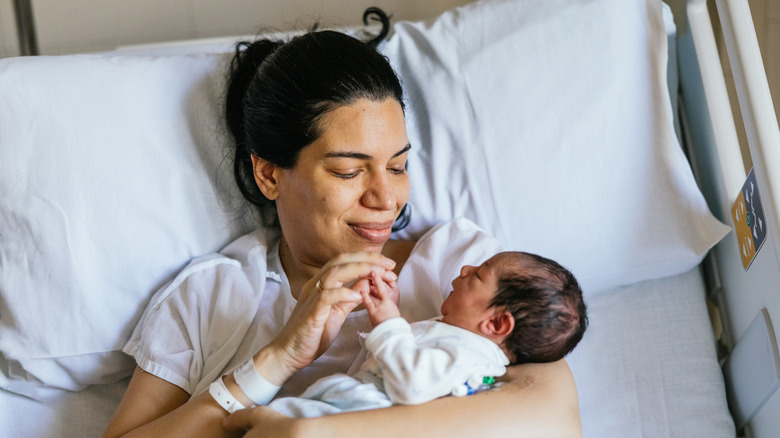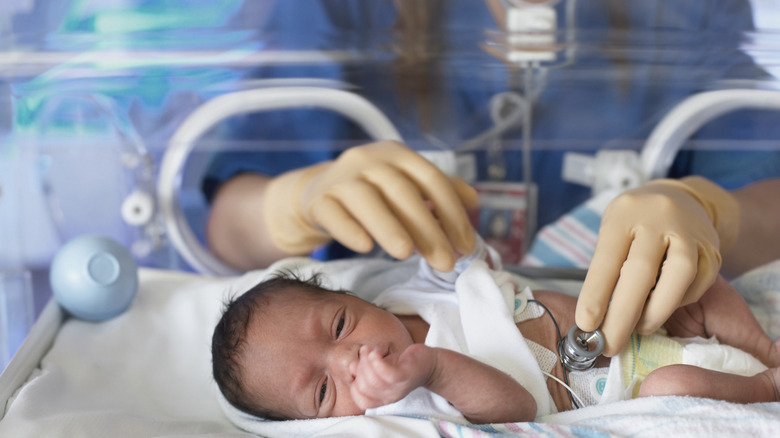The Real Reason Americans Are Going Child Free
According to the National Center for Health Statistics (CDC), the birth rate in the United States has fallen consistently with the exception of a tiny 1% blip of an increase between 2020 and 2021. The birthrate fell by 2% between 2022 and 2023, which is in line with a regular 2% decline in birthrates from 2014 to 2020. Where women of typical childbearing age — 20 to 39 years old — are concerned, the decline is highest at 3% in 2023. In the U.S., discussion about the Americans choosing a child-free existence reached a fever pitch earlier this year after Republican Vice Presidential candidate JD Vance expressed his disdain for the childless cat ladies he believes are ruling the nation. For Vance, the problem was as simple as people wanting to live lifestyles consisting of Beyonce concerts and late nights at the club.
As per the Pew Research Centre, the real answers to this may be a little more complex than immaturity or selfish behavior. While 57% of Americans surveyed, who are 18 to 49 years old and don't want kids, said they just didn't want them, when you look more closely at why, a clearer picture emerges. While the political and economic uncertainty of the times we live in factored into 38% of respondents avoidance of childbearing, and climate change fears were a factor for 26% of respondents, there are also more practical, financial factors that a millionaire like future Vice President Vance — worth an estimated $4.8 million to $11.3 million — may not be considering.
The cost of childbirth and medical debt
One of the reasons why people are exploring what it means to be DINKS is the cost of childbirth. As per the Pew Research Center survey, 36% of people surveyed between 18 and 49 years of age said affordability was a big part of their decisions to not have kids. The Peterson-KFF Health System Tracker confirms that the cost of pregnancy, childbirth, and post-partum care averages $18,865 for those enrolled in group insurance plans, with an average $2,854 being paid out of pocket. These are extra costs that families who don't have children don't have to bear. If a cesarean section is necessary, that cost can go up significantly — to $26,280, with an out of pocket expense of $3,214. While nobody likes to think about it, complications can occur during childbirth. The CDC reports maternal mortality rates in 2021 rose to 1,205 women from 861 in 2020, representing 32.9 deaths per 100,000 live births in 2021 to 23.8 in 2020. A visit to an emergency room, according to the Premier Healthcare Database via Parents, can add $10,700 to your hospital bill.
You don't really want to know what happens if you don't pay your medical bills. According to the Consumer Financial Protection Bureau, 100 million Americans owe $220 billion in healthcare-related bills. Out of that, as per The Peterson-KFF Health System Tracker, 14 million Americans have bills totaling over $1,000, while 3 million claim over $10,000 in medical debts.
Extra money and free time for hobbies and travel
This one may seem selfish, but after considering the cost of childbirth and the debt that could follow it, it makes better financial sense. The Pew Research Center study found that a staggering 80% of respondents between 18 and 49 years old point to having time for hobbies and interests as a reason to not have children. Traveling with a child incurs an extra airfare and a higher fee for your air travel since you'll need to be seated next to your child, and choosing your seats usually comes at a higher price tag. That alone can add $25 to $100 to the cost of your air travel, and that's just one way. Booking a flight with a layover could be your best bet to save as much as 20% on your airfare, however, an impatient child isn't going to be as jazzed to spend three hours in an airport or plane. Although booking a shoulder season vacation can save you money, having a child who is going to school during those times makes it much more difficult to take advantage of, unless you're willing to pull them out of school to do so.
The National Library of Medicine found that hobbies and other extra curricular activities have mental, physical, and social benefits leading to higher overall health outcomes. Raising kids must be priority number one, so for those who aren't willing to temporarily sideline their passions while their kids are young, skipping parenthood altogether seems a responsible choice.
It's easier to generate extra income
We've talked about some of the ways having a child can cost you, but not having a child can also allow you to earn more money. That's because when you don't have the responsibility of kiddos, it's far easier to pick up a side hustle. According to the Population Reference Bureau, in the year 2000, married fathers spent 6.5 hours every week managing their children, while married women spent an average 12.9 hours on childcare. That's 19.4 hours per household that goes toward a child instead of making money. For instance, Personal Shoppers average $15.27 per hour. A Customer Service Representative makes around $18.08 an hour. Neither require more than a GED, and at 19 hours of work, could roughly earn you an extra $290 to $342 per week. In 52 weeks, that's the equivalent of an extra $15,080 to $17,784 per year for retirement savings savings or an emergency fund.
They can focus on their careers
With 44% of adults aged 18 to 49 not having kids because they want to concentrate on other things, it makes sense that one of those things would be their career. When you consider how many more jobs younger generations will have in their lifetime, having more time to work toward a promotion and higher pay can be a benefit a parent may have additional hurdles to accomplish. According to a Gallup poll, 55% of Millennials are just not that into their work, leading to job turnovers that cost the U.S. economy $30.5 billion per year. Since there's an awareness on the part of younger generations that companies don't value your loyalty anymore, they're constantly on the lookout for the next best thing. This kind of flexibility is just irresponsible as a parent. For children, stability is the name of the game, and with 60% of millennials open to work at any given moment, it's understandable why kids may not be in the cards during their most productive years.
For women especially, as per the National Library of Medicine, motherhood comes with being overlooked for management positions — children are seen as a time and focus impediment — and, as a result, mothers tend to receive lower pay than their childless and male counterparts. Also consider that 24% of new mothers leave work in the first year of having a child, with 15% of mothers remaining off the job 10 years later.
It's makes retirement planning easier
When you don't have the household overhead of a child weighing down your finances, you're freer to think about saving for retirement. A 2022 study by the Brookings Institute looked at the cost of raising children — adjusted to 4% inflation after 2021 — and calculated 17 years of expenditures related to children from 2015 to 2032. In 2025, according to the Brooks Institute numbers, the first year of parenthood would cost you an average $17,905, rising incrementally to $24,849 by 2032. Since the table provided by the Brookings Institute bases its total sum calculation on you having a child in 2015 let's look at what that looks like adjusted for inflation. From 2015 to 2032, the total cost to a parent would be $310,605.
Needless to say, $310,605 invested over 17 years is a benefit to your retirement planning. If you're still managing student loans, the money you save by remaining childless can be used to pay them off.
More money for housing
While it may still be too early to be certain how the 2025 housing market will be different from 2024, rising home prices will still be something every homebuyer has to think about. Besides having to navigate the economic factors that control the price of homes, the majority of your household expenses, whether you have a child or not, will come from your home. Rent or own, the numbers speak for themselves. According to the U.S. Bureau of Labor Statistics, in 2023 the overall cost of housing rose by 4.7%, while expenditures on rented and owned properties increased by 7.6% and 5.7% respectively. Obviously, having a child means a need for more space, and bigger space means higher costs.
The initial cost of a larger home, utilities, regular home maintenance, and insuring your home will grow with the size of your residence. As per Experian, Gen Xers and millennials carry an average $308,000 mortgage, the highest average balance of any past generation. Add the cost of a child to that number and you get a sense of why some Americans would just rather not be bothered with the additional expense. Millennials owe an average of $25,000 more than their Gen X counterparts, although Gen X still pays a higher average monthly payment at $2,313 to younger generation's $2,283.
Lower grocery bills
The U.S. Department of Agriculture's (USDA) official food plan cost sheet provides the weekly and monthly estimated cost of food for July 2024. The moderate weekly cost tier starts at $41 for a 1-year-old up to $88.60 for an 18-year-old male — females eat slightly less, reflected in the lower $71.10 for an 18-year-old. Monthly, the average moderate cost of food for kids starts at $177.70 for a 1-year-old, before rising to $384 for males up to 18 — female children cost $258.10. The guide suggests these are estimates based on a four-person household, with a cost adjustment of 20% with the addition of an extra person. So assuming a moderate monthly household expense with two adults 19 to 50 years old — $379.80 for a male and $321.10 for a female — and one male child, you could expect a base of $700.90 plus an additional $177.70 to $384 for each kiddo. In this case, there is no sneaky reason your grocery bill keeps going up since it's pretty straight forward that the more mouths you have to feed, the larger your grocery bill.
Child care is expensive
After paying for pre- and post-natal care while budgeting for an ever rising grocery bill, you still aren't done paying for a child. The Pew Research Centre found 36% of respondents who didn't want children felt that way because they didn't believe they could afford to raise a child. According to the Care.com 2024 Cost of Care Report, Americans are spending 24% of their total household income on child care, with 60% of those households paying 20% more than the previous year. This is a significant cost, borne out by the U.S. Department of Health and Human Services (HHS) estimate of 7% being the total affordable household expenditure on childcare. With the ending of $24 billion in federal funding for the Child Care Stabilization Program in September 2023, 54% of parents surveyed admitted to expecting child care to cost them at least $600 per month a running cost of $7,200 or more per year.
The report goes on to state that other options, like a nanny, pile on expense to the cost of child care. The average cost of a nanny per week was $766 in 2024. Multiply that by 52 weeks and you're looking at a $39,832 per year household cost. Daycare, while cheaper, is still expensive at $321 per week or $16,692 per year. This is big factor in the surprising cost of raising a child.
More of a social life
In Stephanie Dula's personal essay for Pregnancy & Newborn, she recounts her experience as a first time mother trying to navigate her relationship with her friends. In the essay, she describes her interaction with friends after motherhood as "driving in different directions (and) intermittently crashing into each other, cramming as much interaction into that hot minute before driving off again." While this mainly describes her relationships with other parent-friends with children, more difficulty to maintain were her relationships to childless friends. This is supported by a JSTOR journal article that examines how having children early or later can affect your relationships. For younger parents, it's very likely the sharp learning curve of parenting and the aforementioned costs of raising a child will make keeping up with childless friends more of a challenge, and the sort of support you need will lean more toward people with similar experiences who can help you adapt. That doesn't leave much room for dinners out, catch up lattes, or bar hopping on the weekends.
According to the the U.S. Centers for Disease Control and Prevention (CDC) one in eight women with recent live birth's reported postpartum depression symptoms. In fact, mental health factors into 9% of pregnancy-related deaths and can result in mental health issues for the mother. A main driver is isolation leading to loneliness.
The cost of higher education is high
When most people think about raising a child, they tend to think about the crucial years up to 18 years of age, just before adulthood kicks in. If you have a child headed to college, your financial burden doesn't stop quite yet. According to a CollegeBoard study, for 2024 and 2025 the average four-year in-state tuition cost $11,610 per year, with an out-of-state college education costing almost triple that at $30,780 annually. Although President Joe Biden made a final attempt to cancel student debt, the future remains uncertain, and it's probably a safe bet that high tuition isn't going anywhere in the near future. According to the Education Data Initiative, student loan debt in the U.S. is a $1.7 trillion challenge, with 42.8 million Americans on the hook for an average $37,853 to $40,681 as of 2024. In addition, the price for some colleges just hit a very troubling number, suggesting that the trajectory for higher education will be, well, higher.
Student debt can impact an individual's ability to save for retirement or emergencies, lower their credit score if payments are missed, and can even affect their ability to purchase a home if debt-to-income ratio is out of whack. As a parent, you wouldn't want your child to start out in that situation, so you may try to take on some of that burden. Understandably, some people would rather not have a child to focus on paying off their own student debt.










